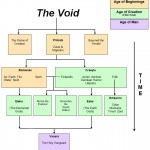Your dictionary defines a pantheon as “the gods of a particular mythology considered collectively”. Rome, Greece and Egypt each had their own pantheons, but on Sangrar, access to the gods, and reverence for them, was not artificially constrained by geographical or cultural boundaries. All ninety-eight Elder Races (yes, I’m excluding the Harnae to keep things simple), could and did offer prayers to any and all gods. Other than the sacred obligation to pray at the Stones and keep the Dark Lord imprisoned, religion was informal and a practice of convenience more than one of strict adherence to ritual. Each Elder Race did have a patron god watching over them who garnered the lion share of prayers, but the patrons were not jealous gods and the people felt free to invoke any god whose gifts might be most useful at that moment.
By the time Man came along, things had changed. Content with heaven, the gods no longer walked the earth like they had in the Elder Days. A few did manage to sneak past the Gates of Heaven and enjoy the pleasures of Sangrar from time to time, but that was rare and they often visited the mortal coil in disguise. As the nations of man rose, formal religion, not unlike those of your world came about, and each country favored a different set of gods. In Colcester, where I cut my teeth, Harnor was the most revered, with the Seeress, the Lady of Esel and Annumbra also holding special places. In Jeheris, the great kingdom of eastern Fanar, Finbardin was worshipped before all others and in Renk, Deridean had the largest temple and greatest following.
The Empire of Sangrithar deserves special mention. Sangrither rose to pre-eminence under the leadership of Thar who was Umbar, the amnesiac God of Sea and Storm who fell to earth from the Heavens. As you’d expect, Umbar was Sangrithar’s foremost god, but the Maiden, known in the Elder Days as the Earth Mother, ran a close second. She had been lost to the world during the Battle of Unending Night and the kingdoms of Man did not know Her, except in Sangrithar, where Kandol Elf Lord, Her high priest in the Elder Days, had taught them.
Note: Zuras and Majestrix, are not included. They were more than gods, they created everything within the Girdle and as the progenitors of all that was, are above such designation.
The Pantheons
The Craeylu (cry-ay-loo): The Gods of Creation, brought forth by Zuras and Majestrix after the Feast of Creation. They created the Ealar and the Elder Races. Also known as the Elder Gods, the Gods of Heaven.
The Ealar (ay-lar): The Earth Gods, brought forth by the Craeylu during the Years of Making, they lived on Sangrar during the Elder Days.
The Elehu (ell-ay-hoo): The Elemental Gods, brought forth by the Elemenes during the Years of Making, they lived on Sangrar during the Elder Days.
The Vanara (va-nar-rah): Also known as the Holy Vanguard, the Vanara were brought forth after the Reckoning to watch over Mankind, in the Heavens and on Sangrar below. Because they are the offspring of Finbardin (Craeylu, who gave rise to the Ealar) and Spirit (Elemenes, who gave rise to the Elehu), most historians count Numra and Annumbra as the first Vanara, even though they hail from an earlier age.
The Elder Gods: During the Elder Days, the Elder Races often called the Craeylu the Elder Gods. During the Age of Mankind, the Craeylu, Ealar, Elehu and were counted as the Elder Gods.
The Gods of Light – This term is sometimes used to refer collectively to the Ealar and the Elehu, the two pantheons that lived on Sangrar during the Elder Days.
The Erlikarrin (ur-luh-care-in): Erlik’s first offspring Morkanis, Cthar, and Zara, the Erlikarrin led the Dark Ones during the Battle of Unending Night. The fourth Erlikarrin, Ymyrl, the daughter of Morkanis and Zara, was the mistress of the Darkhold’s Breeding Pits.


